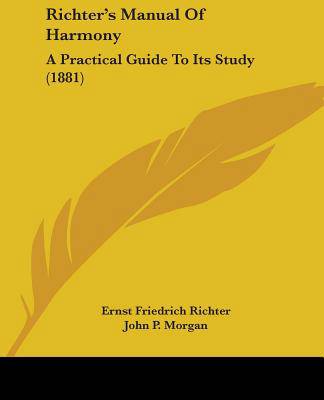
- Afhalen na 1 uur in een winkel met voorraad
- Gratis thuislevering in België vanaf € 30
- Ruim aanbod met 7 miljoen producten
- Afhalen na 1 uur in een winkel met voorraad
- Gratis thuislevering in België vanaf € 30
- Ruim aanbod met 7 miljoen producten
Zoeken
Richter's Manual Of Harmony
A Practical Guide To Its Study (1881)
Ernst Friedrich Richter
Paperback | Engels
€ 37,95
+ 75 punten
Uitvoering
Omschrijving
Richter's Manual of Harmony: A Practical Guide to Its Study (1881) is a comprehensive guide to the study of harmony written by Ernst Friedrich Richter. The book is designed to provide a practical approach to the study of harmony, and it covers a wide range of topics related to music theory and composition. The book begins with an introduction to the basic principles of harmony, including the structure of chords, chord progressions, and the use of harmony in musical composition. It then goes on to cover more advanced topics such as modulation, counterpoint, and the use of harmony in different musical genres. Throughout the book, Richter provides numerous examples and exercises to help readers understand and practice the concepts he presents. He also includes a glossary of musical terms and a list of recommended readings for further study. Overall, Richter's Manual of Harmony is a valuable resource for anyone interested in studying music theory and composition. Its practical approach and clear explanations make it accessible to both beginners and more advanced students of music.Prepared Especially For The Conservatory Of Music At Leipsic.This scarce antiquarian book is a facsimile reprint of the old original and may contain some imperfections such as library marks and notations. Because we believe this work is culturally important, we have made it available as part of our commitment for protecting, preserving, and promoting the world's literature in affordable, high quality, modern editions, that are true to their original work.
Specificaties
Betrokkenen
- Auteur(s):
- Vertaler(s):
- Uitgeverij:
Inhoud
- Aantal bladzijden:
- 224
- Taal:
- Engels
Eigenschappen
- Productcode (EAN):
- 9781437082524
- Verschijningsdatum:
- 1/10/2008
- Uitvoering:
- Paperback
- Formaat:
- Trade paperback (VS)
- Afmetingen:
- 190 mm x 235 mm
- Gewicht:
- 390 g

Alleen bij Standaard Boekhandel
+ 75 punten op je klantenkaart van Standaard Boekhandel
Beoordelingen
We publiceren alleen reviews die voldoen aan de voorwaarden voor reviews. Bekijk onze voorwaarden voor reviews.











